Discover Florida Nature
It's time to explore the natural Florida


|
|
|
|
|
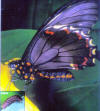 Polydamas
Swallowtail -
The Polydamus Swallowtail lacks the characteristic hindwings tails
common to most other North American members of the swallowtail family.
This trait combined with it's broad, yellow wing span of 4.0- 5.0
inches, makes this butterfly easy to identify. The Polydamus Swallowtail
is a fast and powerful flier with a preference to open areas. Primarily
a tropical butterfly, it is rarely found north of the Florida border.
This is a common butterfly of suburban and urban gardens. Adult
polydamus are good colonizers and readily disperse long distances in
search of suitable hosts. Polydamas
Swallowtail -
The Polydamus Swallowtail lacks the characteristic hindwings tails
common to most other North American members of the swallowtail family.
This trait combined with it's broad, yellow wing span of 4.0- 5.0
inches, makes this butterfly easy to identify. The Polydamus Swallowtail
is a fast and powerful flier with a preference to open areas. Primarily
a tropical butterfly, it is rarely found north of the Florida border.
This is a common butterfly of suburban and urban gardens. Adult
polydamus are good colonizers and readily disperse long distances in
search of suitable hosts.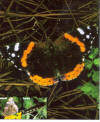 Red
Admiral -The Red Admiral is a medium- sized
dark butterfly with a wing span of 1.75 - 2.50 inches. This butterfly is
quickly distinguished from any other species by its distinctive red
forewing band. Particularly common in spring, the Red Admiral will
readily explore neighborhood gardens. Adult butterflies have a quick,
erratic flight. Male Admirals frequently perch on low vegetation or on
the ground in sunlit locations. The larvae construct individual shelters
by folding together one or more leaves with silk. Red
Admiral -The Red Admiral is a medium- sized
dark butterfly with a wing span of 1.75 - 2.50 inches. This butterfly is
quickly distinguished from any other species by its distinctive red
forewing band. Particularly common in spring, the Red Admiral will
readily explore neighborhood gardens. Adult butterflies have a quick,
erratic flight. Male Admirals frequently perch on low vegetation or on
the ground in sunlit locations. The larvae construct individual shelters
by folding together one or more leaves with silk.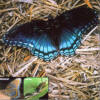 Red-Spotted
Purple - The Red-Spotted Purple, although lacking a hindwing
tail, mimics the toxic Pipevine Swallowtail to gain protection from
would be predators. Red-Spotted Purples, with a wingspan of 3.0 - 3.5
inches, are common butterflies of immature woodlands but are rarely
encountered in large numbers. Adult butterflies have a strong gliding
flight and are often quite wary. Males perch on sunlit branches along
trails or forests borders and make periodic exploratory flights. Adults
occasion visit flowers but often prefer rotting fruit, dung, carrion, or
tree sap. Red-Spotted
Purple - The Red-Spotted Purple, although lacking a hindwing
tail, mimics the toxic Pipevine Swallowtail to gain protection from
would be predators. Red-Spotted Purples, with a wingspan of 3.0 - 3.5
inches, are common butterflies of immature woodlands but are rarely
encountered in large numbers. Adult butterflies have a strong gliding
flight and are often quite wary. Males perch on sunlit branches along
trails or forests borders and make periodic exploratory flights. Adults
occasion visit flowers but often prefer rotting fruit, dung, carrion, or
tree sap.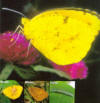 Sleepy
Orange-There is great debate on how the Sleepy Orange Butterfly
got its name. One interpretation is that the butterfly's narrow black
forewing spots looks like a closed eye. Whatever the reason for its name
the Sleepy orange is far from sleepy. With a wingspan of 1.3 - 2.0,
adult Sleepy Orange are extremely active and have a quick nervous
flight. Another of Florida's migratory butterflies, Sleepy Orange
produced late in the season move south and overwinter in reproductive
diapauses. Newly emerged male Sleepy Orange often gather together in
large numbers at mud puddles or damp ground. Sleepy
Orange-There is great debate on how the Sleepy Orange Butterfly
got its name. One interpretation is that the butterfly's narrow black
forewing spots looks like a closed eye. Whatever the reason for its name
the Sleepy orange is far from sleepy. With a wingspan of 1.3 - 2.0,
adult Sleepy Orange are extremely active and have a quick nervous
flight. Another of Florida's migratory butterflies, Sleepy Orange
produced late in the season move south and overwinter in reproductive
diapauses. Newly emerged male Sleepy Orange often gather together in
large numbers at mud puddles or damp ground.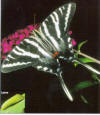 Zebra
Swallowtail- The black and white Zebra Swallowtail can be
confused with no other butterfly in Florida. Adults have a low rapid
flight, and with their 2.5 - 4.0 inch wingspan, they adeptly maneuver
among understory vegetation. Male Zebra Swallowtails regularly patrol
their territory for females. This swallowtail has a shorter proboscis
and is thus unable to nectar at many long, tubular flowers. Zebra
Swallowtails instead prefer composites and are strongly attracted to
white flowers. Summer-form individuals are larger, darker, and have
longer hindwing tails. Zebra
Swallowtail- The black and white Zebra Swallowtail can be
confused with no other butterfly in Florida. Adults have a low rapid
flight, and with their 2.5 - 4.0 inch wingspan, they adeptly maneuver
among understory vegetation. Male Zebra Swallowtails regularly patrol
their territory for females. This swallowtail has a shorter proboscis
and is thus unable to nectar at many long, tubular flowers. Zebra
Swallowtails instead prefer composites and are strongly attracted to
white flowers. Summer-form individuals are larger, darker, and have
longer hindwing tails. Spicebush
Swallowtail
-The Spicebush Swallowtail is one of four Florida butterflies that
mimic the toxic Pipevine Swallowtail to gain protection for predators.
Adult Spicebush are strong agile fliers with a wingspan of 3.5 - 5.0
inches, but this butterfly rarely strays far from its preferred woodland
habitat. A true lover of flowers, the Spicebush Swallowtail readily
ventures out to nearby open areas in search of nectar. These butterflies
continually flutter their wings while feeding. Larvae create shelters by
curling up the edges of leaves with silk. They rest motionless inside
when not actively feeding. At maturity the larvae turn yellow and search
for a site to pupate. Spicebush
Swallowtail
-The Spicebush Swallowtail is one of four Florida butterflies that
mimic the toxic Pipevine Swallowtail to gain protection for predators.
Adult Spicebush are strong agile fliers with a wingspan of 3.5 - 5.0
inches, but this butterfly rarely strays far from its preferred woodland
habitat. A true lover of flowers, the Spicebush Swallowtail readily
ventures out to nearby open areas in search of nectar. These butterflies
continually flutter their wings while feeding. Larvae create shelters by
curling up the edges of leaves with silk. They rest motionless inside
when not actively feeding. At maturity the larvae turn yellow and search
for a site to pupate. Tiger
Swallowtail
- Easily recognized by its bold black stripes and yellow wings, the
Tiger Swallowtail is one of Florida's most familiar butterflies. With a
wingspan of 3.5 - 5.5 inches, adults have a strong able flight and often
soar high in the treetops. Commonly seen in Florida gardens, the Tiger
Swallowtail are readily drawn to flowers. Male Tiger Swallowtails often
congregate in large numbers at mud puddles or moist ground. Dark form
females mimic the toxic Pipevine Swallowtail to gain protection. Tiger
Swallowtail
- Easily recognized by its bold black stripes and yellow wings, the
Tiger Swallowtail is one of Florida's most familiar butterflies. With a
wingspan of 3.5 - 5.5 inches, adults have a strong able flight and often
soar high in the treetops. Commonly seen in Florida gardens, the Tiger
Swallowtail are readily drawn to flowers. Male Tiger Swallowtails often
congregate in large numbers at mud puddles or moist ground. Dark form
females mimic the toxic Pipevine Swallowtail to gain protection.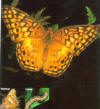 Variegated
Fritillary
- The medium sized Variegated Fritillary shares its affinity for open,
sunny habitats with the similar looking Gulf Fritillary, but is
generally less common and highly localized in occurrence. With a
wingspan of 1.75 - 2.25 inches, the Variegated Fritillary adult has a
low erratic flight, but it regularly stops to nectar at available
flowers. This butterfly is an occasional visitor to Florida gardens. Variegated
Fritillary
- The medium sized Variegated Fritillary shares its affinity for open,
sunny habitats with the similar looking Gulf Fritillary, but is
generally less common and highly localized in occurrence. With a
wingspan of 1.75 - 2.25 inches, the Variegated Fritillary adult has a
low erratic flight, but it regularly stops to nectar at available
flowers. This butterfly is an occasional visitor to Florida gardens. Viceroy
- The colorful Viceroy has a quick, gliding flight and is often wary and
difficult to closely observe. Males perch on overhanging branches and
occasionally dart out to explore their territory or investigate passing
objects. Unlike the Viceroys found throughout most of the Eastern United
States, the Florida subspecies is a darker richer mahogany brown and
more closely resemble the Queen butterfly. Together the Viceroy, Queen
and Monarch form a Mullerian mimicry complex in which all three
butterfly species are highly distasteful or toxic to certain predators.
Bright orange Viceroys, with their wingspan of 2.6 - 3.20 inches can
often be found in North Florida. Florida
Butterflies: Explore the nature side of Florida Viceroy
- The colorful Viceroy has a quick, gliding flight and is often wary and
difficult to closely observe. Males perch on overhanging branches and
occasionally dart out to explore their territory or investigate passing
objects. Unlike the Viceroys found throughout most of the Eastern United
States, the Florida subspecies is a darker richer mahogany brown and
more closely resemble the Queen butterfly. Together the Viceroy, Queen
and Monarch form a Mullerian mimicry complex in which all three
butterfly species are highly distasteful or toxic to certain predators.
Bright orange Viceroys, with their wingspan of 2.6 - 3.20 inches can
often be found in North Florida. Florida
Butterflies: Explore the nature side of Florida |
|
|
Advertise | Privacy Statement | Contact | Alaska Nature | Michael Arnold Art| Dog Encyclopedia | Dog Encyclopedia| |
|